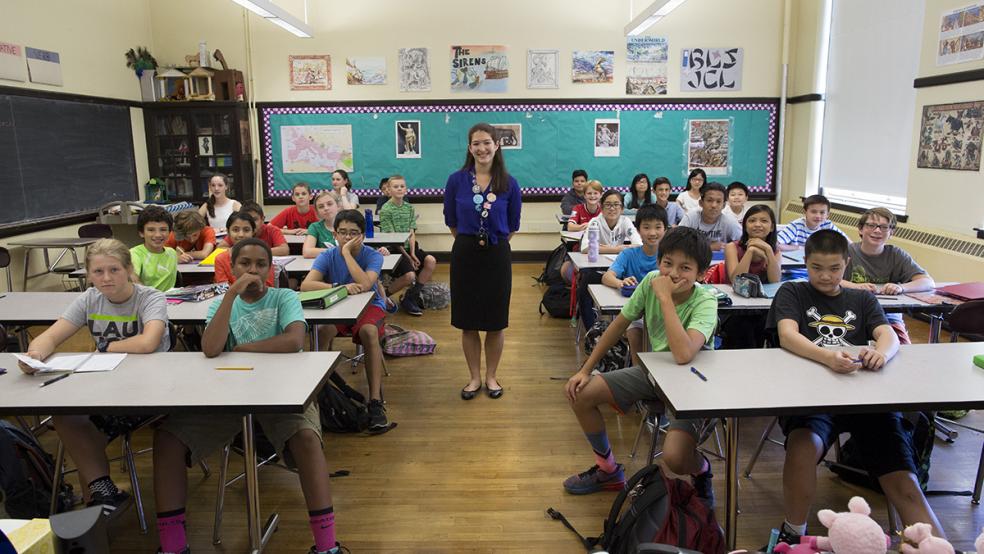More than seven years after the end to the Great Recession, an alarming number of elementary and secondary education programs throughout the country continue to operate with diminished budgets that experts say are diluting the quality of education, lowering test scores and hurting local economies.
Even while many areas of the country have finally bounced back from the worst of the recession, at least 23 states are providing less general funding for kindergarten through 12th grade education this year than when the recession began, according to a new study by the Center on Budget and Policy Priorities, a liberal-leaning think tank. Moreover, eight other states have slashed general funding per student by 10 percent or more in recent years. And five of those eight – Arizona, Kansas, North Carolina, Oklahoma and Wisconsin – compounded the problem by cutting taxes, leaving less money available for education funding.
Related: States Face a $1 Trillion Pension Problem: Here Are the Worst 10
While every jurisdiction and state has a different story to tell about the residual effects of the worst and deepest recession since the Great Depression, the overarching theme is that many school districts have had to cut corners, enlarge the size of their classrooms and operate with smaller teaching staffs. The cumulative effect has undermined schools’ capacity “to develop the intelligence and creativity of the next generation of workers and entrepreneurs,” the study declares.
In all, 35 of 50 states provided less overall state funding per student during the 2014 school year (the most recent available data) than in 2008, shortly before the recession fully took hold, according to the report. Among the worst cases are Arizona, Idaho, Alabama, Florida, Georgia and California, where per capita spending on students is as much as 20 percent to 37 percent below 2008 spending levels when adjusted for inflation.

The study stressed that deep funding cuts have hampered efforts in many school systems to implement reforms. For instance, while the number of public school teachers and other workers has declined by 221,000 since 2008, the number of students in K-12 has grown by 1.1 million. At a time when producing workers with sophisticated technical and analytical skills has been deemed critically important by government policy makers and educators, “large cuts in funding for basic education could cause lasting harm,” the study states.
“It is very concerning,” Michael Leachman, the lead author of the study and the center’s director of state fiscal research, said in an interview on Thursday. “Public investment in our schools is crucial for the country’s future -- for our future economy and for our quality of life.”
Related: Obamacare Rate Hikes for 2017 Even Bigger Than Expected
The recession placed enormous pressure on state and local budgets from coast to coast as tax revenues dried up. That prompted deep cuts in an array of areas, including health care, police, human services, higher education and K-12 programs. The federal government provided emergency fiscal aid to prevent even deeper cuts in programs and services, but those funds ran out before the economy had bounced back.
Part of the problem was that property values plummeted in many areas amid the mortgage crisis and recession, which led to sharp declines in property taxes that are used in many jurisdictions to finance public schools. And rather than taking a balanced approach with a mix of service cuts and revenue increases, many states “chose to address their budget shortfalls disproportionately” through spending cuts, according to the report.
Additionally, a handful of states led by Republican Govs. Sam Brownback of Kansas and Scott Walker of Wisconsin pushed through major tax cuts in an effort to rejuvenate their state economies that seriously worsened their revenue shortfalls. Other states that approved major tax cuts include Arizona, Oklahoma and North Carolina.
“They’ve really slashed support for their elementary and secondary schools a lot,” Leachman said. “And because they also cut income taxes, they’re going to have a hard time finding revenue to reinvest in their future workforce.”
Among other problems, Oklahoma, Kansas and Arizona are faced with serious teacher shortages, inadequate pay levels and oversized classrooms, according to the report. Some of the Republican state legislators in Kansas who backed Brownback’s major tax cuts that triggered a budgetary crisis lost their primary reelection contests earlier this year and are being replaced by legislators who may revoke some of the tax cuts. On Election Day, voters in Oklahoma will vote on a proposed increase in the sales tax to generate additional revenues for schools and teachers’ salaries.
Related: 24 US Cities With the Fastest Rising Home Prices
Leachman said that more recently, many states have begun reinvesting in their schools as the economy has gradually improved, both in terms of rising property tax revenue and increased state appropriations. Nonetheless, he said, “It was a very hard recession when you look at what happened to state revenues.”
“One worry that I have is that we’re going to hit another recession,” he added. “It’s been almost nine years since the last recession started and the average business cycle since World War II is between six and seven years, so we’re a little bit working on borrowed time.”
Leachman wrote the report with Kathleen Masterson and Marlana Wallace.






